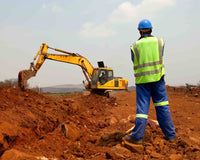 This post is meant to give a brief overview of these requirements. To learn specifics and more in-depth requirements, visit NFPA website.
This post is meant to give a brief overview of these requirements. To learn specifics and more in-depth requirements, visit NFPA website. As of January 1, 2009, the NFPA 1901 Standard for Automotive Fire Apparatus requires that all Fire Apparatus Vehicles must have Public Safety Vests that meet ANSI/ISEA 207. To learn more about ANSI/ISEA 207 approved Safety Vests click here. NFPA 1901 includes additional safety standards that are required for Automotive Fire Apparatus' to be equipped with in order to maximize firefighter capabilities and minimize risk of injuries. NFPA Standards for Fire Apparatus applies to contracts signed on or after January 1, 2009. In addition to ANSI/ISEA 207 Public Safety Vests, NFPA 1901 safety standards include, but are not limited to, the following:
Public Safety Vests:
- One vest for each seating position
- Five-point breakaway feature - two at the shoulders, two at the sides, and one at the front (NFPA)
Vehicle Data Recorder:
- Capture data once per second in 48 hour loop
- Minute by minute summary stored for 100 engine hours
- Software to download information (NFPA)
Vehicle Stability:
- Requires one of the following:
- Remain stable to 26.5 degrees in both directions on tilt table
- Calculated center of gravity no higher than 80% of vehicle height
- Have a vehicle stability system (NFPA)
Additional Equipment:
- One traffic vest for each seating position
- 5 fluorescent orange traffic cones
- 5 illuminate warning devices
- 1 automatic external defibrillator (AED)
- Step ladder or multipurpose ladder (must meet ANSI A14.2 or ANSI A14.5) (NFPA)
Diesel Particulate Filter - if provided:
- Regeneration process must be activiated by two methods:
- Automatically by the engine system
- Manually when initiated by activiation of a switch
- Switch required that will inhibit DPF regeneration
- Icon to indicate that the DPF requires active regeneration (NFPA)
Low Voltage Electrical
- 45 amps on minimum continuous electrical load
- Ground lighting and surface lighting
- Driving/crew compartment interior lighting
- Compartment lighting at floor with no shelves, dividers, or equipment (NFPA)
Seat Belts:
- Type 1 - Lap Belt 60 inches
- Type 2 - Pelvic and upper torso 110 inches (NFPA)
Retroreflective Striping:
- At least 50% retroreflective strippping in a chevron pattern sloping downward at a 45 ° angle
- Each strip 6 in. in width (NFPA)
Aerial Devices:
- Minimum rated capacity constant throughout entire operating envelope
- Interlock required to prevent operating into an unstable position
- An indicator to allow the operator to determine maximum extenstion (NFPA)
Foam Systems:
- Required to be tested and certified by final installer at 3 specific test points (NFPA)
Air Systems:
- Compressor required to have air quality monitoring (NFPA)
Trailers:
- Type I - remain connected to tow vehicle and are dependent on each other for required electrical power and conspicuity
- Type II - allow separation from tow vehicle after arrival and are not dependent on the tow vehicle for electrical power
- Type III - open trailers designed to transport other vehicles, equipment, or containers that will be used off the trailer. (NFPA)
 This post is meant to give a brief overview of these requirements. To learn specifics and more in-depth requirements, visit NFPA website. As of January 1, 2009, the NFPA 1901 Standard for Automotive Fire Apparatus requires that all Fire Apparatus Vehicles must have Public Safety Vests that meet ANSI/ISEA 207. To learn more about ANSI/ISEA 207 approved Safety Vests click here. NFPA 1901 includes additional safety standards that are required for Automotive Fire Apparatus' to be equipped with in order to maximize firefighter capabilities and minimize risk of injuries. NFPA Standards for Fire Apparatus applies to contracts signed on or after January 1, 2009. In addition to ANSI/ISEA 207 Public Safety Vests, NFPA 1901 safety standards include, but are not limited to, the following: Public Safety Vests:
This post is meant to give a brief overview of these requirements. To learn specifics and more in-depth requirements, visit NFPA website. As of January 1, 2009, the NFPA 1901 Standard for Automotive Fire Apparatus requires that all Fire Apparatus Vehicles must have Public Safety Vests that meet ANSI/ISEA 207. To learn more about ANSI/ISEA 207 approved Safety Vests click here. NFPA 1901 includes additional safety standards that are required for Automotive Fire Apparatus' to be equipped with in order to maximize firefighter capabilities and minimize risk of injuries. NFPA Standards for Fire Apparatus applies to contracts signed on or after January 1, 2009. In addition to ANSI/ISEA 207 Public Safety Vests, NFPA 1901 safety standards include, but are not limited to, the following: Public Safety Vests:




